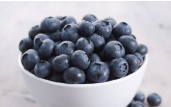This cross-sectional study of 1,898 women aged 18-75 years examined associations between habitual flavonoid intakes and direct measures of arterial stiffness, central blood pressure, and atherosclerosis. Total flavonoids and their subclasses were calculated from validated food-frequency questionnaires while arterial stiffness and atherosclerosis were measured via central systolic blood pressure (cSBP), central diastolic blood pressure, mean arterial pressure (MAP), augmentation index, pulse wave velocity (PWV), and intima-media thickness. A higher anthocyanin intake was associated with significantly lower mean cSBP (-3.0 ± 1.4 mm Hg for highest versus lowest quintiles; P-trend = 0.02), MAP (-2.3 ± 1.2 mm Hg for highest versus lowest quintiles; P-trend = 0.04), and PWV (-0.4 ± 0.2 m/s for highest versus lowest quintiles; P-trend = 0.04). A higher flavone intake was associated with a lower PWV (-0.4 ± 0.2 m/s for highest versus lowest quintiles; P-trend = 0.04). No associations were observed for total and other flavonoid subclasses. These data suggest that higher intake of anthocyanins and flavones are inversely associated with lower arterial stiffness. The intakes of anthocyanins associated with these findings could be incorporated into the diet by the consumption of 1-2 portions of berries daily. Am J Clin Nutr. 2012 Aug 22. PMID: 22914551
Home Research News Higher anthocyanin intake is associated with lower arterial stiffness and blood pressure









